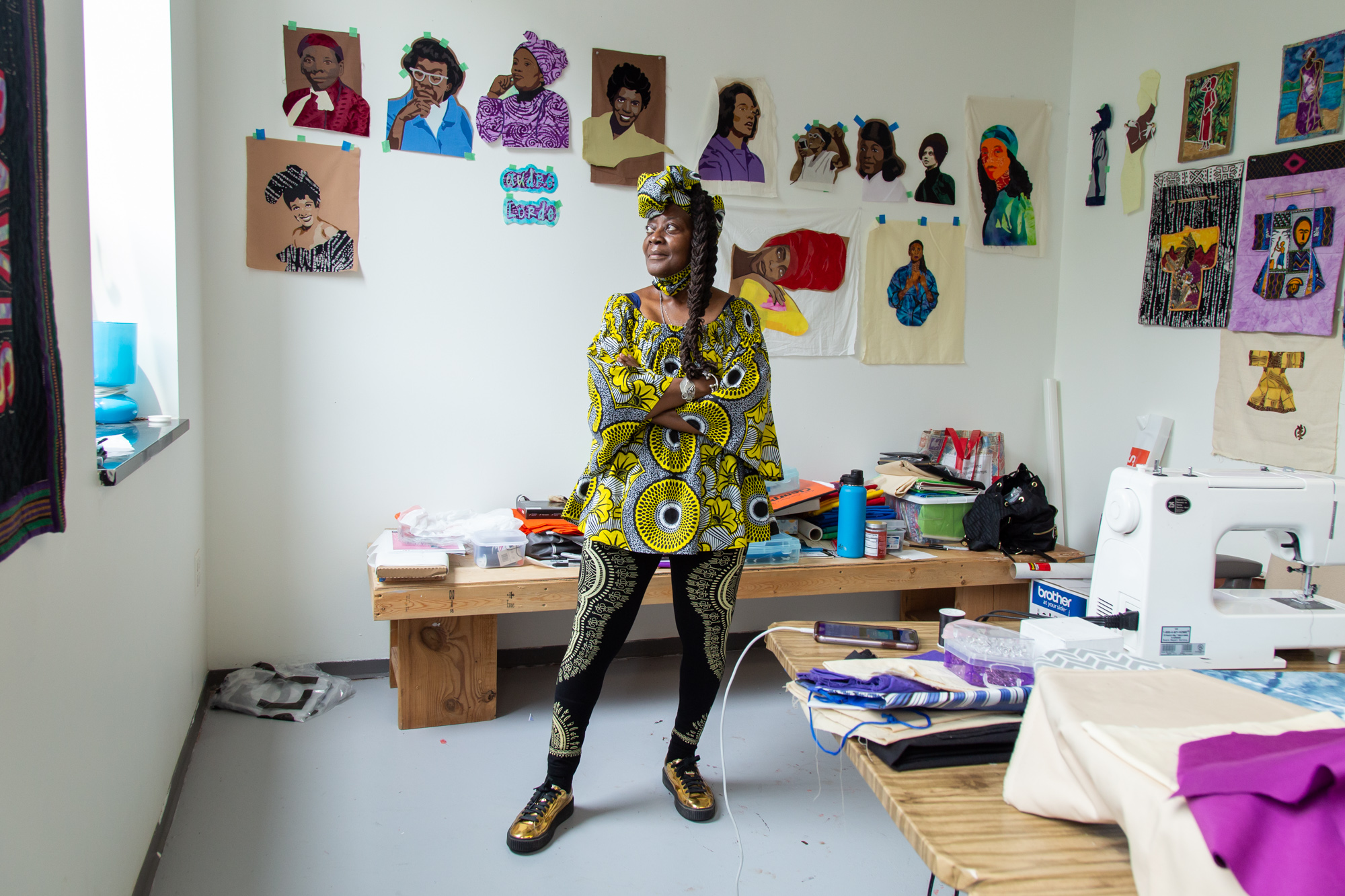Featured image: A full-length portrait of artist Dorothy Burge standing in her studio at Hyde Park Art Center. She wears a top, head wrap and pants with black, yellow, and white patterns. In the foreground is a table with a sewing machine and sewing materials. Behind her is another bench with sewing and other materials. Along the wall are fabric portraits of iconic Black women including Lena Horne, Harriet Tubman, Gwendolyn Brooks, Coretta Scott King, Kathleen Cleaver, and others. Photo by Joshua Clay Johnson.
I’m not even sure how to frame what you’re about to read. The following interview with Dorothy Burge is a shortened version of a marathon studio visit, a two and a half hour conversation that included multiple belly laughs, tearful retellings, sounds from cell phone videos, future works, and multiple deep-cut lessons in Chicago’s social, political, and economic histories.
It is a lesson on how art works, too. Our conversation is a testimony of the natural and unpredictable development of an artistic practice and how art—actually artists—can lead the way to legislative change, in this case through a groundbreaking reparations ordinance for survivors of police torture in Chicago.
Dorothy Burge has lived many lives. These lives are defined by her personal experiences and time spent studying, teaching, and applying elements of industrial design, urban planning, policy, storytelling, and quilting to the benefit of the people around her. The ways she puts her knowledge to work have resulted in clear come-ups for countless people, but they have, too, been useful in fortifying her sense of self. She won’t hesitate to let you know that her life-long relationship to design, such as her style and her upbringing in high-rise public housing, has been a sharp tool that has led her into a deeper understanding of value systems, autonomy, privilege, and biases within educational and professional settings.
Maybe the best thing for me to do is get out of the way so that you can get into it.
It wasn’t easy, but the following interview has been edited for clarity and length.
Tempestt Hazel: I want to start off with a grounding question. How are you doing Ms. Dorothy?
Dorothy Burge: Pretty good. I’m calm and relaxed. Today’s my daughter’s birthday. She celebrates because she was born, and I celebrate because I gave birth. I think I should also be acknowledged on this day.
TH: Yes! Because you did some work. How would you begin to describe where you’re at today in your practice versus when you first began?
DB: I have a degree in industrial design from the University of Illinois at Chicago (UIC). I was told later in life when I met some other people who came through industrial design at UIC that [students were] complaining about the lack of African Americans in industrial design. They looked it up to see how many African Americans went through the program, and [after researching it] these young people asked me, “Did you know that you were the first African American to graduate with a degree in industrial design in the 1970s?”
I did not know that, and I don’t know if it’s true, but that’s what they told me. I know when I was there taking classes, I was the only Black person in my classes. For the first three years I was the only female.
TH: Wow. Do you remember when you weren’t the only woman anymore?
DB: Yes, there was a white woman in one class. And she didn’t stay in the program.
TH: If it’s true that you are the first to graduate from the program, or even within the first five Black people to graduate from the program, what goes through your mind when you hear something like that?
DB: It was a very interesting time, in the 70s. I had really good teachers. I did experience quite a few microaggressions. But at that time in my life, I was around 18 or 19 years old, coming out of high-rise public housing, and I was really focused on who I was and what I wanted to do with my life. So, I couldn’t care less if people didn’t like me or if they didn’t like my work—as long as the people who were supposed to be giving me the knowledge and skills were doing what they were supposed to do.
One of the reasons I was able to stay in the industrial design program was because I took a Black studies course every semester. That’s how I stayed connected to who I was and other issues that were important to me.
TH: And were the demographics of those classes different?
DB: Yes, almost entirely Black. People from other backgrounds were not taking Black studies in the 70s. So it was almost all us.
TH: Then, you ended up sticking with UIC, right?
DB: Yes. I graduated, got an industrial design degree, then went to the Urban Planning and Policy program to get a masters.
TH: I’m curious about those choices. First, I wonder if the makeup of the classroom changed when you moved into the graduate program…
DB: Not very much.
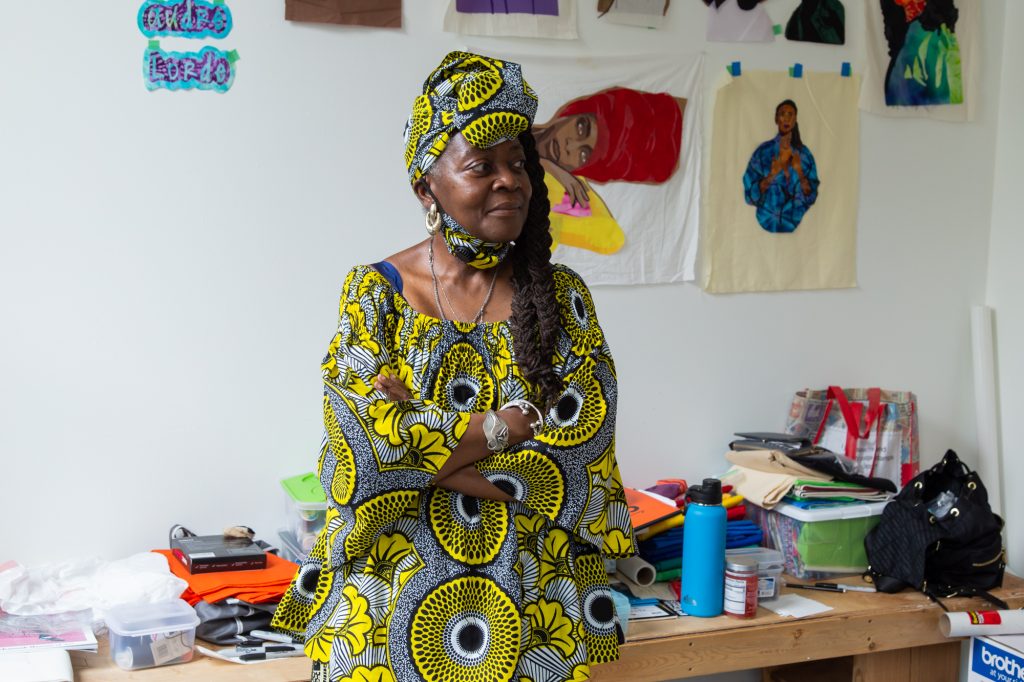
TH: Second, what motivated you to go into these programs? I don’t want to say it’s unexpected. But I think about, for instance, for myself, no one ever really talked about a curator or arts writer as career options, so I never knew to even ask about them. To decide to go into industrial design as a teen is pretty amazing.
DB: I actually started in the architecture department. I liked doing architectural design, but I hated everything that went with it. I hated structures, I hated math, so after a year I needed to find something different. The art department and architecture department were in the same building, so I started looking around in classes and decided to try [industrial design] and I really liked it. We were designing some of everything. We thought about designing solar houses – that was fascinating to me. I realized I could use my design skills and mix it with art, which is something I like to do. We had assignments where we design cars, and I wasn’t really into cars, but I was interested in designing toys for African American kids. I realized I could create something different—something I didn’t have growing up.
TH: So, then how was urban planning?
DB: I went through undergraduate school on work-study programs. I spent two years as a work-study student in the Black studies program while taking industrial design classes. Then, a job came up in the graduate program that wasn’t work study, and it paid more money—a dollar more an hour was a lot! Then, when talking to the head of the [industrial design] program during my last year in undergrad, he asked me what I wanted to do after I graduated. I told him that I wanted to go into urban planning and policy because I wanted to go back to my neighborhood and do something in my community. He then asked if I was going to go to graduate school. I explained that I would need to take some time off and make some money first. Then he suggested that I apply to graduate school because I might get a scholarship and I didn’t think about that. I found out later that I ended up getting a scholarship because of him. They gave me a fellowship where I got free tuition and fees and also an internship with the Northeastern Illinois Planning Commission. I was able to learn planning and go through [graduate] school without any tuition or fees.
TH: Wow. I love to time travel a little bit in interviews. You started in architecture, then went into industrial design, then went into urban planning and policy. The urban planning and policy came about because of the industrial design, and the industrial design came because of its proximity to architecture. It sounds like at the heart of everything is architecture. What was it about architecture that drew you to it in the first place?
DB: I went to Lindblom High School (Lindblom Math & Science Academy), which was a technical high school, and we were required to take drafting. I took three years of drafting, math, and science. It was a very structured college prep program. I really wanted to go to an HBCU (historically Black college and university), but didn’t have the money to do that. UIC gave me the scholarships, but when I came out I still owed UIC about four thousand dollars. I thought that was an incredible amount of money. Now that I look back, I realize it wasn’t.

TH: Yes—it is a different time as far as the cost of education goes. You weren’t walking around with a ruler at a young age, measuring walls and drawing houses or anything like that?
DB: No! And that’s one of the reasons why architecture was so difficult. Imagine you grow up in high-rise public housing and you get to college where one of your assignments is to design a house. Well, I’d never been in a basement. I didn’t know the structures of things like that. I went in thinking about what looked good to me, not how to put the structural elements together. That was a real challenge for me. All of my friends were in public housing too, so I didn’t have examples I could go to in order to see the kinds of things we were learning about.
TH: Thinking about the relationship between architecture and your own experience makes me wonder whether or not you think that your life experiences made you think about or approach what you were learning in a way that was different from that of your classmates?
DB: Absolutely. I’ll give you an example. My thesis was called A Case of Genocide, and it was about public housing. I was doing research on high-rise public housing and architects who were saying things about what public housing residents do and don’t deserve in their apartments and buildings. For instance, if you’re in a high-rise building, there are 16 floors of plumbing that are all connected. So, if something happens with your plumbing, you have to go to every neighbor and let them know not to flush the toilet while the plumber was there because it would flood every apartment. Those experiences really impact you as a child. Another example is something like the elevators not working and then finding out the reason they didn’t work was because the elevator and all of the electronic equipment that made the elevator function was placed in a box that was directly exposed to the elements, when it could have been easily enclosed and we would not have had those elevator breakdowns.
I also learned that if you look at the Robert Taylor Homes, they are really similar in design to a prison. It’s designed gallery-style where you can walk by and look into everyone’s house before you get to your own—very similar to a prison. That impacted me in a way that let me know that this needs to be brought to everyone’s attention and it’s impacting people in a negative way.
TH: I can’t imagine what UIC was like in the 70s, but today I see it as an interesting place with some really brilliant folks teaching and going through the programs there—though I won’t go into the complicated history of its campus expansion. That said, I feel that the questions and insights you were raising would be welcomed with open arms today. How were they received back then?
DB: In some ways it was well-received and then there were other people who said that because it’s so personal to me that I shouldn’t write a thesis, I should write a novel. But I didn’t want to write a novel, I wanted to document what I was seeing. So, I switched my advisor from the person who kept telling me to write a novel. Once I switched, my new advisor said, “This is good. Go with it.”
TH: I still find myself being shocked by the subtle and overt ways that systems of power are reinforced by people at all levels and in so many ways. That was a big moment in your life and research, and to have someone attempt to derail you by telling you this isn’t the right direction for something they know little about is always wild to me.
DB: And that still happens to this day. People will see my quilts and they’ll say, “All of your quilts are about heavy issues. Why don’t you start doing fun quilts.” I have to say to them that when fun is seen as a wonderful thing for African American communities to have in this country, then I will start doing “fun” quilts. But until then, I’m quilting from the perspective of an African American woman and mother, and things that impact me. That is what I do. As a woman and a mother, if I’m able to stop worrying about my children being killed by police, gun violence, or sexual assault, then I will do more uplifting quilts.
TH: For people who make those comments about your work, it reveals a lack of understanding of what your quilts are about, in my opinion. I want to know what they’re searching for in the word “fun.” “Fun” can include uplifting and joyful things but also acknowledge the weighty realities of life.
DB: And I’ve met some really incredible people who speak to that. Renaldo [Hudson] coming out of prison was incredible, and I had fun dancing with him and doing The Spank—only people in our generation know how to do that. We were doing a workshop with Alice Kim, and the purpose of the workshop was to create patches that would send a message to people who had died of COVID-19 while incarcerated. We asked students at the University of Chicago who were part of Alice’s seminar to come up with phrases that were six words or less, to send a message. We were all sitting out in the quad, and I suggested we put music on and Renaldo asked—and you should know that they all call me “Ma”—and Renaldo said, “Ma, do you know how to do The Spank?” And I was like, “Duh, do you know how old I am? Of course I know how to do The Spank.” So there we were, out in public, doing The Spank.
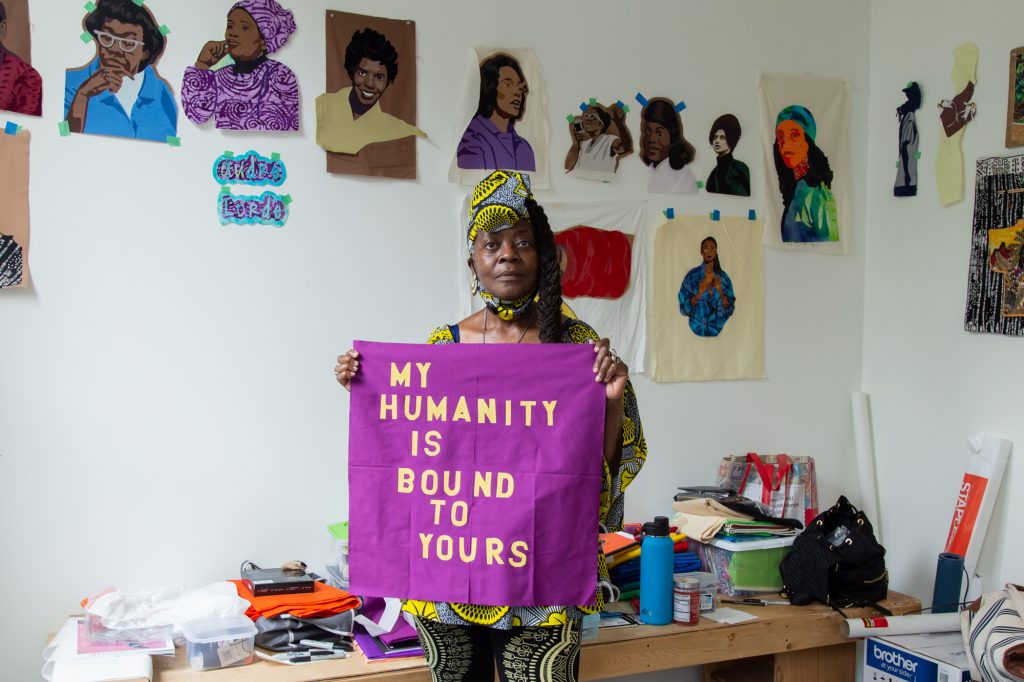
TH: You’ll have to show me how to do The Spank!
If we jump back again and do a little bit more time traveling, what came next after you left UIC with these two degrees?
DB: Then I went to the Woodstock Institute and did research on lending patterns and redlining. I studied where banks were lending, who was and was not getting mortgages, and African Americans being denied GI loans and things like that. This raised my awareness of the banking industry and insurance issues. When I moved to Bronzeville (Chicago) in 1987, we could not get a mortgage. I had been banking at First National Bank [of Chicago], which is now Chase bank, since I was in college—from 1972 to 1987. I had good credit, and they would not give me a loan. I ended up switching from them in order to get a better rate.
Insurance was also an issue. Initially, State Farm wouldn’t insure us. Allstate wouldn’t insure us. Bronzeville was really redlined in the 1980s.
TH: The 80s aren’t that long ago at all.
DB: After I left the Woodstock Institute, I went to work at the Voorhees Center for Neighborhood and Community Improvement at UIC helping with grassroots community development and strategic plans—things like that. One of the things that was very interesting to me was integration maintenance, which is something that was happening all over the country where people would decide the tipping point [for how many African Americans could move into a neighborhood] before whites didn’t want to live there anymore. So, certain communities like Oak Park said that they would do integration maintenance, keeping the number of African Americans at [or under] twenty percent. They claimed to believe in integration, but they thought in order for them to maintain an integrated community, then they needed to figure out how to limit the number of African Americans to twenty percent. I spoke out against integration maintenance.
TH: Integration maintenance is such a strange term. It’s actually segregation maintenance. I was recently listening to an interview with Cleo F. Wilson, the former executive director of Intuit [The Center for Intuitive and Outsider Art], who spoke about Willis Wagons and how she was part of a group called Maverick CORE that was protesting those for similar reasons. They were protesting that and other policies and programs that were put into place to maintain racist practices in housing and education.
DB: Also, think about Lake Meadows and Prairie Shores. Ferd Kramer was a “fair housing advocate” until too many African Americans were moving into Lake Meadows. He then got on the side of integration maintenance. He was sued and lost, then he was no longer a supporter of integration because his buildings were turning into predominantly African American buildings.
TH: Wow, I didn’t know that history! When I think of Lake Meadows, I think of the ways it has shown up in my archive research because of the art fairs that were organized there under people like Dr. Margaret Burroughs. I’ve always kind of thought of it as predominantly Black from the start.
DB: No, Kramer was trying to maintain the twenty percent limit for African Americans.
And speaking of Dr. Margaret Burroughs—I had a very interesting experience with her and my daughter. My daughter went to the Betty Shabazz [International Charter] School and then went to King [College Preparatory] High School. During this time my daughter was a docent at DuSable Museum. Margaret Burroughs actually signed one of her prints and gave it to [my daughter]. Then, [recently] I was doing a talk about Bronzeville and, to prepare, my daughter and I were driving around the neighborhood so that I could take photos for the talk. I wanted to get photos of Dr. Burroughs’ house because I wanted to talk about how it was the original DuSable Museum and how she lived in the coach house and turned her home into a museum. I’m just going on and on like she didn’t know this already, when she then asked, “Are you going to talk about the Pullman Porters?” I told her no because this is about Bronzeville. She says, “Well, you know that before Dr. Burroughs owned it, this building was owned by Pullman Porters?” I had never heard that!
TH: Really?
DB: So, I had to go back and do the research. Because Pullman Porters could not get places that were nice to live and hang out, this became one of those places—they lived there and had events there. She learned it while she was a docent at DuSable [Museum].
TH: I hadn’t heard that either. To go back to your time post-school, at what point did you start to think of yourself as an artist?
DB: Never.
TH: And what about today?
DB: I think of myself more as a quilter. After leaving [the Voorhees Center at] UIC, I went to work for the United Way of Chicago in a new program they created called program planning. I was going out to nonprofits, evaluating them, and helping them to develop all of the places that they are weak so that they can get United Way funding. I was going into communities that other planners were afraid to go into—African American neighborhoods. For example, who was willing to go into Cabrini [Green]? I was willing to go into Cabrini. Who was going into Austin, Lawndale, Robert Taylor? I was going to all of these places, I wasn’t afraid. I was in all of these different communities, working with grassroots organizations and meeting some incredible human beings.
Another story is one about Wentworth Gardens public housing development. When I first had my daughter, I was meeting with a woman who lived there and she said, “We have lots of young people here who wouldn’t mind doing daycare for you—they will come to your house.” They interviewed people and found someone to come to my house and take care of my daughter for the first year of her life. My daughter would have been there longer but [the caretaker’s] sister died in childbirth and she had to go and take care of her sister’s kids. To have that kind of connection and learn from them [was important].
Here’s something else that I’ll never forget. I was on a panel about public housing to talk about the research I’d done for A Case of Genocide. I invited the women from Wentworth Gardens to come to the presentation and they came—they came strong. After giving my presentation someone from the audience asked me a question. I can’t remember what the question was but it was something like, “What are the conditions like now [in public housing].” I remember telling them what I thought conditions were like now and what needed to be done.
I was in my twenties, and afterwards these elders [from Wentworth Gardens] pulled me aside and said they wanted to talk to me. They said, “We’re really proud of you but don’t ever speak for us. If they wanted to know what public housing was like now, we were in the audience and they could have asked us.”
I went home and cried, because I thought to myself, “How disrespectful had I been?” But I learned the lesson. And it was a really wonderful lesson that I keep with me all the time.
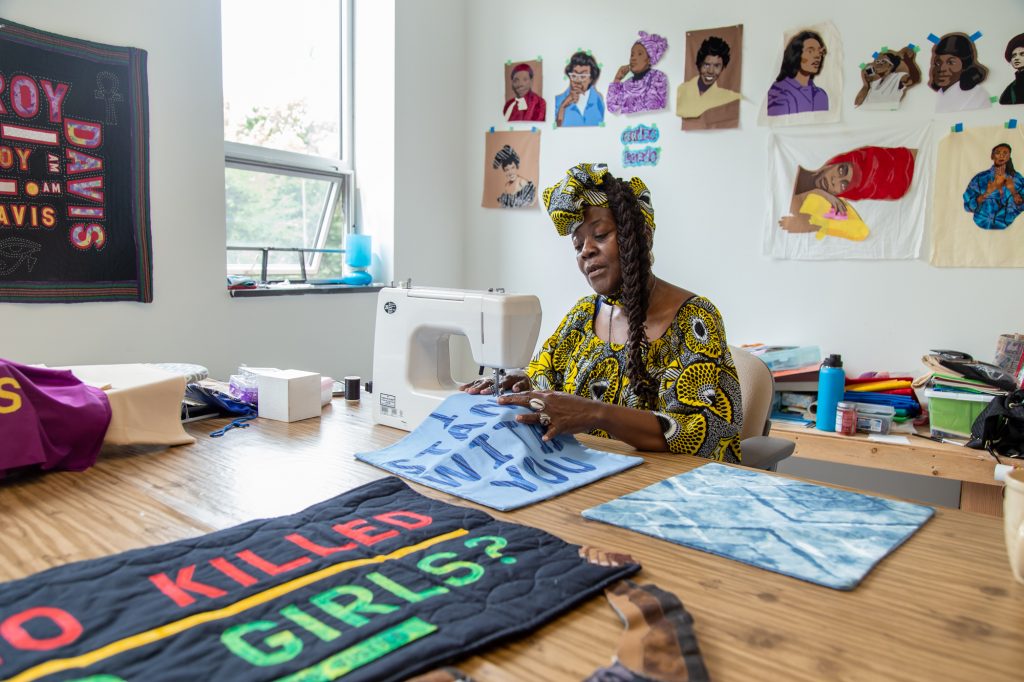
TH: Wow. That makes me think about what you do now. With your quilts and what we’re seeing here in your studio. You have these fabric portraits of iconic women, many of whom aren’t here with us anymore. I often think about our role in keeping, preserving, and telling the stories that continue to build on their memories and carry them forward. But then, when you’re working with or speaking of people who are still around, especially those who are incarcerated, they can speak for themselves.
DB: Exactly. When I do workshops like the one where we created messages for survivors of [Chicago police torture under] John Burge, I have survivors speak because I can’t speak for them. They went through this traumatic life with twenty or thirty years of being incarcerated for a crime they didn’t commit and being tortured. Nobody believes you or people believe you but don’t think it’s important enough to do something about.
TH: Was there ever a point when those two things came together in your consciousness, the direct connection between the lesson that you learned from the residents at Wentworth and what you do now with your quilts?
DB: Yes. When I left United Way and then went to teach at the Associated Colleges of the Midwest in their urban studies program. This program brought students from 13 liberal arts programs around the country to do an experiential program about Chicago neighborhoods and urban issues.
TH: When was this?
DB: From 1991 until 2019—I worked there 26 years. It was incredible, I loved it. I was in every neighborhood. I was meeting with different community leaders and activists. It was an incredible learning experience for me and the students.
Everything was intertwined. My family will tell you—when I saw something interesting happening [while I was on the bus], I would hop off the bus fast to see what was happening and ask questions.
TH: I bet you had the best program!
DB: We would go everywhere. We would be in Little Village and do the toxic tours of the contaminated land and how the land is still contaminated where Cook County Jail sits. Places where people would have to dig up their lawn, put down gravel, and then put new soil down. Many of these students had not heard about this kind of environmental injustice. They were mostly wealthy white students, so this was very new to them. It was an incredible experience to learn about these different issues and then to connect them with the people who are really doing this work.
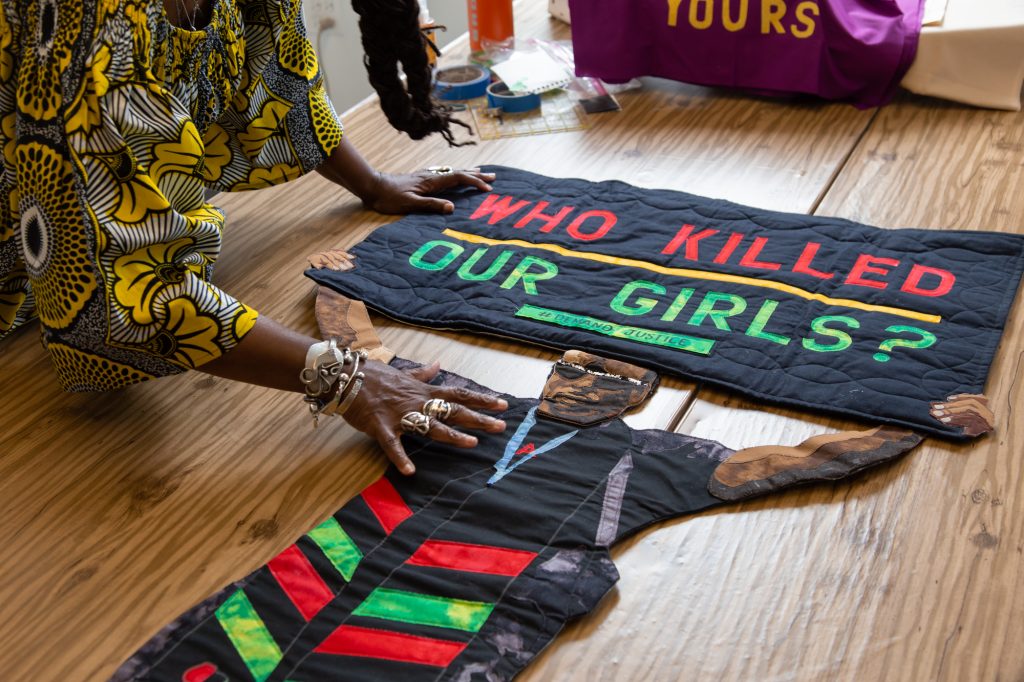
TH: And the moment when you connected these things…
DB: In the 1990s, I met Stan Willis who was an attorney. There was an organization called the Committee to Free Mumia [Abu Jamal] and Aaron Patterson—Aaron Patterson was one of the Death Row Ten. George Ryan was the governor at the time who ended death row and executions in Chicago. He also freed four of the Death Row Ten. Anti-death penalty was my first push into criminal justice activism although in college I did fight to free [Nelson] Mandela. The Committee to Free Mumia morphed into Blacks Against Police Torture. Then, by interacting with other activists, we came together to do the Chicago Torture Justice Memorials (CTJM) where we were using art to raise awareness about John Burge. When I was on the Committee to Free Mumia and Aaron Patterson, I would be asked to create banners, so I would create banners. They would ask me to design a t-shirt, so I would design a t-shirt. This is how I started using art with activism.
Originally, I started doing art as a hobby because I wanted to have Black art in my house that I couldn’t afford to buy. Then, CTJM did an exhibition called Citizen’s Picnic in 2008. They asked me to create a piece to go into that exhibition. I created two: one on James Cameron who survived a lynching in the 1930s—not in the South, but in Marion, Indiana. I also did a quilt on Ida B. Wells.
I would also make art just to give people as gifts. But then, when certain things happened , I would make a piece. Like, for example, my Troy Davis piece. I created that because Troy Davis was going to be executed [in 2011] and I wanted to do something. I took this banner with me to go out and protest. I did a banner for Trayvon Martin and was protesting with that banner at a lot of different events happening here in Chicago. People would come up to me and ask to take a picture of it. [I created a banner for] Hoodies Up Day with my church, when people were saying that wearing a hoodie was “suspicious.” I took a photo of my great great nephew in his carrier with Skittles and iced tea and created a banner based on that, then took it to a protest. A lot of my banners use children and that matters to me. Children break the barrier. People say things like, “Trayvon could have been my son…” but then when you see baby pictures of Trayvon, I really see how yes, this could have been my son. Because I have a huge family I decided that I would use the kids in my life.
Then, I document people who are being forgotten. Like Pat Hill from the African American Police League. I don’t feel she’s being remembered in the way she should be remembered, so I wanted to do a quilt to honor her. She was the first African American woman to lead the African American Police League and fight against racism in policing while on the police force. She was fired five times for her activism and had to go to court to be reinstated each time. She had to fight for the most ridiculous things. This is the one that got me: Pat had an ankh earring in her ear and her supervisor tried to terminate her because earrings were against dress code. She had to go to court to get put back on the force because of this. With all of the marches she was a part of and marching against John Burge and police torture, she put her job on the line all the time. I feel like she needs to be honored and hasn’t gotten the honor she deserves.
Also, attorney Standish Willis—reparations [for victims of Chicago police torture] was his idea. I don’t think they talk enough about where that idea came from. My quilts are a way of documenting history also.
Then, the mothers of the movement—mothers who have been fighting for 20 years to get their sons out of prison. They need to be honored, too.
When I hear something or see something that impacts me and I want to preserve that history, I’ll put it in a quilt.
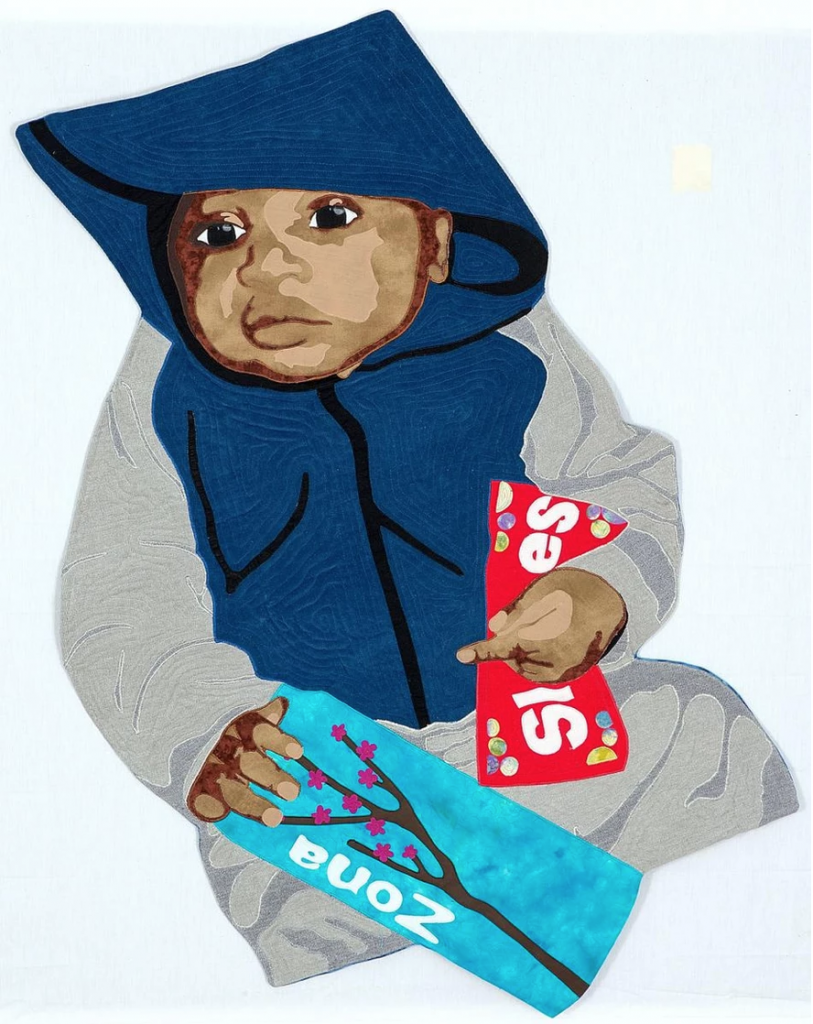
TH: Who taught you how to make quilts?
DB: When the Citizen’s Picnic show happened, the Women of Color Quilters Network created a series of quilts, and I was blown away. I went to the head of the WCQN and asked, “Do you ever take quilts from people who do quilts but aren’t really quilters?” She asked me if I do quilts, and I told her that I wasn’t sure if you would call them quilts. She asked me to show them to her. I showed her the Trayvon quilt from a picture on my cell phone, and she asked me to send her the quilt so that she could look at it—a quilt that I later got signed by Trayvon Martin’s mother and father. But I didn’t just send that quilt, I sent her every quilt I had done.
She called me up and told me that I have really good ideas, but my quilting skills suck! I needed to learn how to quilt. I joined the Quilters Guild to learn.
TH: Putting your work out there in front of someone who does things at the level that she does takes some bravery.
DB: Well, not really! I tell people all the time that when you’re in any art program, like in industrial design, you have to take your drafts, put them on the wall, and everyone critiques it. I was used to that kind of critique. You listen to it, you take what is good advice, and leave what doesn’t work for you. I wish we would do more critiquing now. It’s not a bad thing. The problem now is that we don’t teach people how to critique. Critiquing isn’t just about pointing out what is wrong with an artwork, it’s also about saying what works, what is good, and what can be improved. Now, people don’t critique in the same way that they used to.
TH: I completely agree with you when it comes to that. So, it sounds like this was a really important turning point in your work, technique-wise. This was huge also because quilting has such a long history and tradition in it. You’ve spoken before about there being quilters in your family, also about you being from the South, from Mississippi. Can you talk about the links between you making work in this tradition and also having the direct familial connection.
DB: My grandmothers quilted, my mother quilted. My great grandmother quilted. My grandmother on my father’s side made us all quilts, handmade—there were seven of us. We did not appreciate the value of those quilts then. I look back now and not having those quilts breaks my heart. Coming from that background, [I saw how they] used fabric to send a message. When I started, I would give my quilts to family members. I did a quilt called The Seven Sisters about my grandmother and her six sisters at the funeral of my great grandmother when I was seventeen. They were all standing in a line, dressed in black. [It’s based on an old photo] I found in Mississippi and got restored. When creating the quilt, I took them all out of the black clothes and put them in African clothes, which they liked!
TH: Who do you feel your work is in conversation with? We could talk about a lot of artists—we can talk about the prolific work of the Gee’s Bend Quilters. Or the work of Faith Ringgold, Beverly Y. Smith, Bisa Butler, or Billie Zangewa. I am definitely a believer in the fact that nothing is new and that we all are working on continuums, pulling from generations of work and inspiration. Then, when it comes to art that is put to work within movements, I think of Aram Han Sifuentes’ and the Protest Banners Lending Library. Can you talk a bit about your aesthetic and material inspirations?
DB: I learned by watching an HGTV show called Simply Quilts, before HGTV went into home improvement. I would get up at 7am and watch jewelry-making and the quilting techniques they demonstrated on Simply Quilts. While watching it I was thinking, “I can do that.” And finally my husband asked me, “then why don’t you do it?” So, I did it.
I had not seen many art quilters—I’d seen traditional quilts and then Gee’s Bend’s improvisational quilts. Those quilts were functional, they used old clothes. But then I saw Faith Ringgold painting on fabric and then quilting it. I tried that after seeing her work. Also, Alice Beasley. I liked her technique, and she’s another artist who tells stories with her quilts. Also, Dr Carolyn L. Mazloomi—the founder of the Women of Color Quilters Network—who did quilting and then started painting on fabric and turned those into quilts. These are people I’ve been inspired by. These are pieces I did twenty years ago. Right now, many people might look at my work and think that I’m inspired by Bisa Butler, but really it’s Alice Beasley.
TH: Despite what’s happening currently, it’s hard to pinpoint where inspiration comes from because quilting has such a long history.
DB: Right! There’s also [Wycliffe] Lincoln Bennett who is an incredible artist and who does collages. I took a workshop with him, and he showed me how to do colors in faces and portraits. I take workshops all the time and am always learning. Another woman who inspires me is Carolyn Crump. She uses paint and colored pencils on fabric.
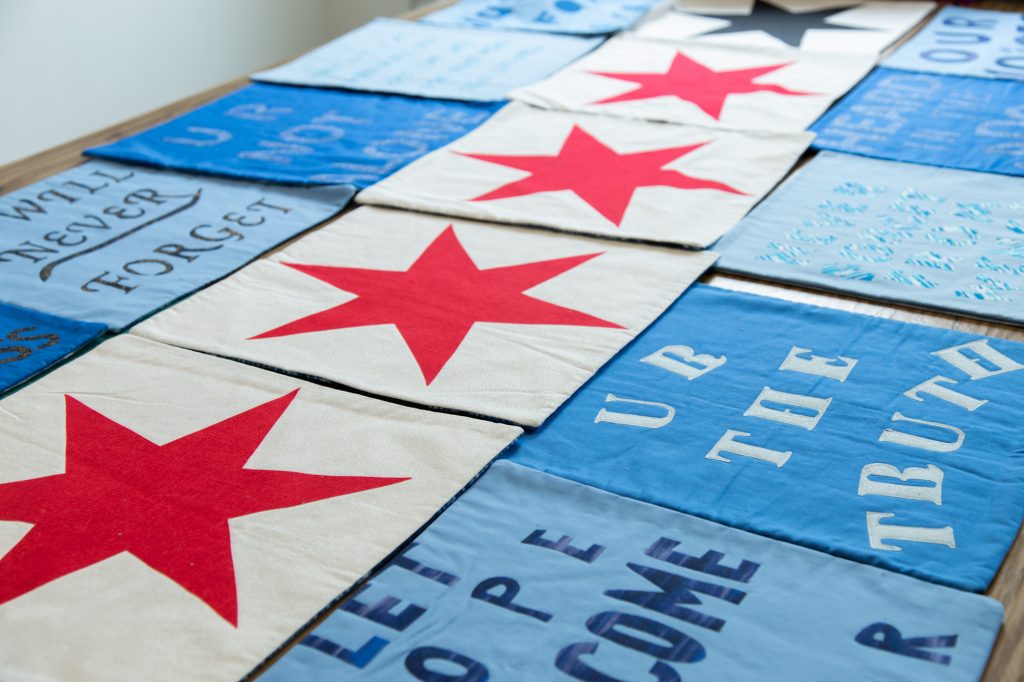
TH: Continuing in the conversation about inspiration, can you talk about the current series of portrait quilts you’re working on and your work with Chicago Torture Justice Memorials?
DB: I was talking with people at the Chicago Torture Justice Memorials and the Chicago Torture Justice Center about what we need to do to really push for the fact that the reparations ordinance said that there is supposed to be a memorial to honor the survivors of John Burge. The city has gone back on that and they continue to not want to fund it. They’re being really nasty about it, and we want to raise awareness about the memorial and the fact that we are not going to let this die. We need them to continue teaching about it in CPS schools. They need to continue funding the Chicago Torture Justice Center in order to give these folks the kind of social services they need and give them free college tuition down to their grandchildren as promised.
One of the torture survivors was very active in the movement to free Gerald Reed and he asked me to do [a quilt]. I had met Gerald Reed’s mother, Amanda Shackelford, who has been working for decades to get him out. And there was an exhibition called Freedom Dreams at University of Illinois at Chicago that Alice Kim and the Prison + Neighborhood Arts/Education Project (PNAP) put together. For the exhibition, I was given a piece by Gerald Reed that he wrote about his mother and they told me to use this piece as inspiration to do the quilt. I called his mother and asked if she had any photos of her son [that I could use]. The only photos she had of him were from before he was incarcerated, and other than that it was only mug shots. I had to use a Polaroid to make this quilt, but I couldn’t put the faces in because the photo was so blurred that I couldn’t see [them clearly]. That quilt now hangs at the Chicago Torture Justice Center.
Then, I was talking to a survivor, Mark Clements, and he said they were really trying to get Gerald Reed out. So, I started [this new quilt series] to raise awareness, and started this quilt before Gerald was released. He’s been released now. Mark then told me that there were 26 other people who are still incarcerated. I said I would try to put together a series on the 26 people who are still incarcerated. As we’re fighting for the memorial, we can also be fighting to get them out of prison. When they’re out of prison, they will have the quilts. And for those who aren’t out, we will use them to continue raising awareness.
TH: They’re really powerful pieces.
DB: Having to use mug shots [for the portraits] and then using patterns and fabric to try and not make them look like a mug shot is really important to me. I want them to look distinguished because they are.
TH: I think the use of color and pattern definitely communicates that. Twenty-six is so many people and portraits. What kind of pace are you setting for completing these pieces?
DB: When I first started this, I thought I should be able to finish each of them in about a week. But, no. It takes me about a month each. When these are released, I have to be able to tell the story of each of these men. I have to do my research on when they were arrested, who was involved—all of that.
There’s going to be an exhibition at Depaul Art Museum next year. However many of the twenty-six quilts I have finished by that time will be in the show. There’s also going to be an exhibition for the Women Quilters of Color Network, and I was asked to do a series on what has happened over the last year when it comes to African Americans being killed. So, I’ll be doing a series on the protests that have been happening over the last several years. I’ll be doing all of these at the same time.
TH: Then you have the message quilt with the six word messages to incarcerated people who have died of Covid-19…
DB: Yes. It’s very encouraging to see people give their messages and how people receive the messages, and to have events where someone like Renaldo can see people making these patches and him knowing some of the incarcerated people who died of Covid-19. Or having a woman who was incarcerated reach out to me saying that someone they knew died of Covid-19 and asking if a patch can be created for her.
We also did a quilt series called, “What Does Justice Look Like?” with messages for torture survivors. I hope all of these will be ongoing with workshops to build on each series. We can lay them out like the AIDS quilt.
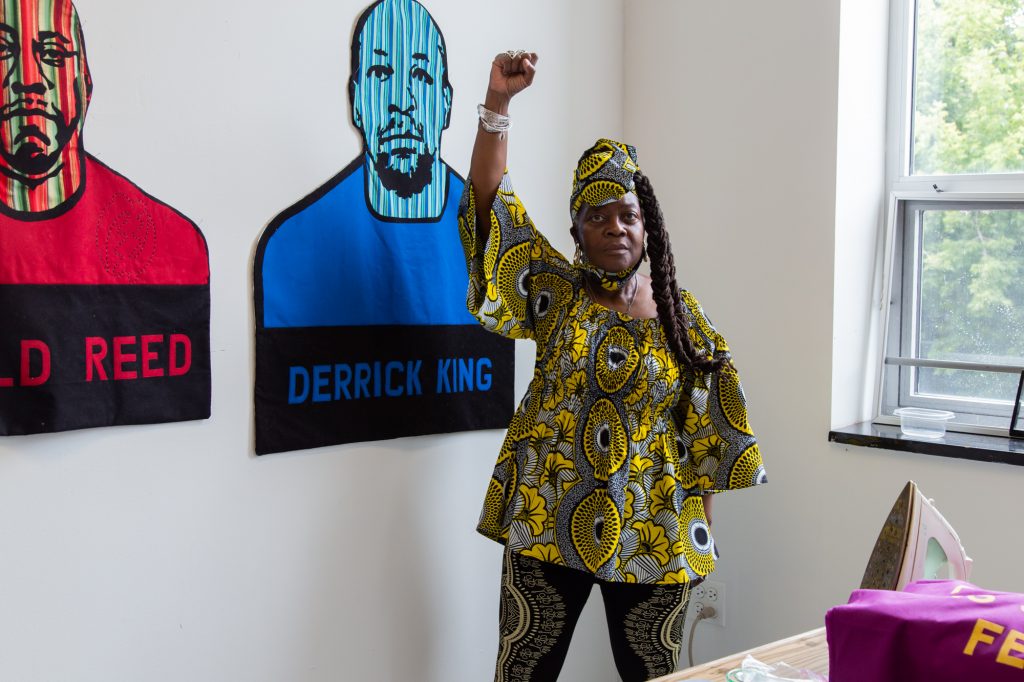
TH: I can’t let this conversation go by without pointing out that you are a very stylish person, known for your love of patterns, in your artwork and also in your clothing. Did your love for bold fabric in your art and in your personal style develop alongside one another?
DB: When I got out of school I started working at the Woodstock Institute where many of the board members were very wealthy. I would attend these board meetings, and I could not afford to dress up. So, I went out and bought all of these white blouses and I would just change my skirts from day to day. One day, one of the women who worked as the office manager said to me, “Do you sew?” And I said yes, I used to make dashikis years ago. She then took me to some stores in the Gold Coast. I’d never been to the Gold Coast. She took me into these high fashion boutiques and they’re waiting on us hand and foot. She suggested I try different things on. We left there and went to Vogue Fabrics in Evanston where we saw the same exact fabrics that were used for the clothes at the boutiques. She then took me to the pattern books, we picked out the same patterns and then we made the same clothes that we tried on. She went to the International Academy of Merchandising and Design, so her skills were impeccable. It took her about a year to really teach me how to sew. I started making all of these designer clothes.
Then, while I was working at UIC, a woman I went to school with later came to me and says someone was looking for me. I asked her how she knew someone was looking for me. I asked her how she knew they were looking for me, and she said they described me. She says, “You know, the Black woman in the designer clothes.” I was ticked. They weren’t describing me as a person or my work. They were only talking about my clothes.
Now, let me also say what used to happen to me when I wore designer clothes. Imagine, you’re at an event, a fundraiser. You’re standing there, minding your own business, and someone—who is white—walks up to you and [without asking] pulls at your clothes to check the tag. It got to the point where I could see them coming and had to tell people not to touch me. Instead of asking me who the designer was, they decided to treat me like I was some kind of mannequin.
I decided to go back to my roots after I graduated from the urban studies program. I cut my hair and went completely natural and started wearing African clothes. That was twenty-six years ago. The great thing about African clothes is that they are never in style so they are never out of style!
TH: You’re pairing it with the Air Jordans. I could talk to you all day, but my last question is this: What is something that you want people to know and understand about you and your work?
DB: The thing that I’m most concerned about is cultural appropriation within my work. I don’t want to appropriate anyone’s story or be seen as somebody who was trying to get over by documenting something horrific that has happened to someone. To me, the important thing is that as I’m documenting this history. I hope that it’s moving people to do something about the injustices that they see. I’ve never sold any of my work. I always think about passing it down to other generations as a way to document history. I’m really honored to be part of the Women of Color Quilters Network because our work is traveling all over and we’re telling the story of what’s happening to us as African Americans in this country. I think that’s really important.
Almost every time I finish giving a talk someone who is not a person of color will ask me the question, “why don’t you quilt about happy things?”
TH: What response comes up for you?
DB: My response is that they usually don’t have to worry about the same things that I worry about. If you had to live with the kind of trauma that African Americans live with in this country, you would not be [making work] about happy things all the time. Art is a way to heal. Art is a way to tell a story. If someone figures out that art is the way they want to tell their story or do their healing, I don’t think anyone needs to be stepping in and making judgements about it.
There’s another thing that I have mixed emotions about because I know that artists need to make money. But when you see artists who are, for example, making money off of George Floyd who have no real interest in justice for George Floyd or his family, or other people, then that bothers me. I’m not bothered by young people on the frontlines and are making t-shirts [for the cause]. I’m going to buy that t-shirt. But if Walmart is selling that, then it’s an issue. These things have me conflicted.
TH: What are your thoughts on the energy that surrounds the work? In my experience, it’s a special kind of energy. When I talk to you, or Alice , or Renaldo, you all give a special kind of energy.
DB: I’d never met Gerald Reed in person at this point, but I can’t tell you how happy I was to see him on TV when he was released. I felt like it was time for us to celebrate. When you meet these folks, they’re such incredible human beings. Like Eric Blackmon—his story is incredible to me. To come out, to be working on a law degree, to now be a Soros Fellow, and he’s just as humble and nice as ever.
Now, I just need money to go buy them all African clothes. Since they call me “Ma,” and I’m their mother, I feel like I’ve got to put them in stylish African clothes.
TH: I think we’re all ready for the House of Dorothy Burge.
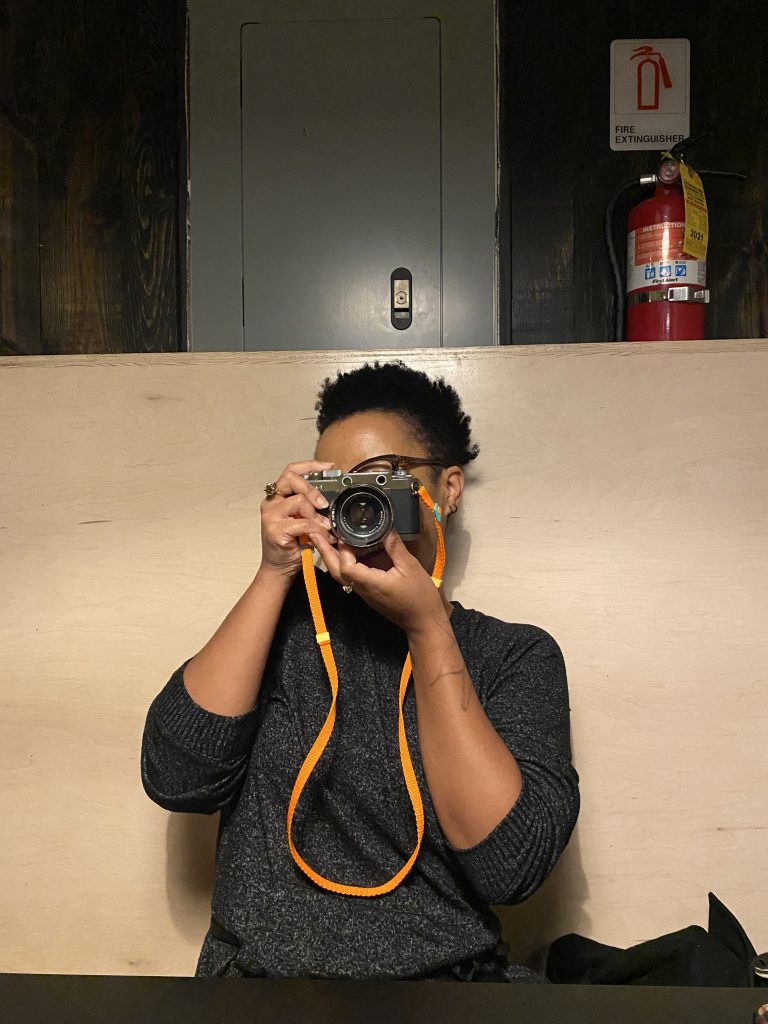
Tempestt Hazel is a curator, writer, artist advocate, and co-founder of Sixty Inches From Center. Find more of her work at tempestthazel.com. Photo by Matt Austin.
